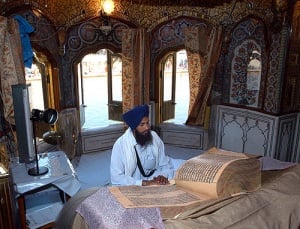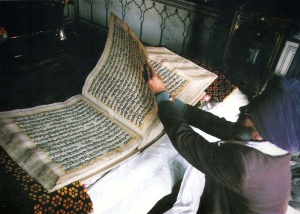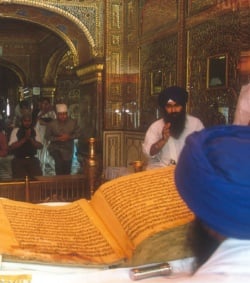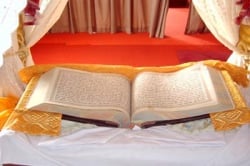Guru Granth Sahib
Guru Granth Sahib or Adi Sri Granth Sahib Ji (Punjabi ਗੁਰੂ ਗ੍ਰੰਥ ਸਾਹਿਬ; also called the Adi Granth or Adi Guru Darbar) is more than just a scripture of the Sikhs, for the Sikhs regard and respect the Granth (holy book) as their living Guru. The revealed holy text spans 1430 pages and contains the actual words spoken by the founders of the Sikh religion (the Ten Gurus of Sikhism).
Guru Granth Sahib was bestowed the Guruship by the last of the human form Sikh Masters, Guru Gobind Singh Ji in 1708. Before passing away, Guru Gobind Singh Ji decreed that the Sikhs were to regard the Granth Sahib as their next and everlasting Guru. Guru Ji said – “Sab Sikhan ko hokam hai Guru Manyo Granth” meaning “All Sikhs are commanded to take the Granth as Guru”. So today, if asked, the Sikhs will tell you that they have a total of 11 Gurus. (10 Gurus in human form, and the eternal shabad Guru, the Guru Granth Sahib).
Unique amongst the world's major religious scriptures, while compiling the Guru Granth Sahib, the Sikh Gurus incorporated not only their own writings, but also included the writings of other contemporary saints from Hinduism and Islam (including saints belonging to the lowest strata of untouchables in the Hindu Caste System), who believed in the unity of God and denounced superstition and caste. Further, the composition and compilation of the Guru Granth Sahib was performed by the Sikh Gurus themselves, rather than being performed by their adherents and followers, an aspect that has been highlighted by historian-scholars while discussing the authenticity of the preachings of the different teachers and prophets of the world, as known to mankind today.
When one visits a Gurdwara (a Sikh temple), the Guru Granth Sahib forms the main part of the Darbar Sahib or Main Hall. The holy book is placed on a dominant platform and covered in a very beautiful and attractively coloured fine cloth. The platform is always covered by a canopy, which is also decorated in expensive and very attractive coloured materials. The text in which the Granth is written is a script called Gurmukhi (literally "From the Guru's mouth"), which is considered a modern development of the ancient language called Sanskrit.
History & Composition of Guru Granth Sahib
Guru Nanak brought the Word of God to manifest upon Earth. Through his Hymns and Prayers (Shabads), he inspired and uplifted humankind to live a life of truth, righteousness and spirituality. These enlightening words were sung by his companions, Bala and Mardana, and by the Sangats (congregations) tha grew up around Guru Nanak. In his later years at Kartarpur, it became customary for the members of the Sikh community to sing certain hymns on a daily basis: Japji in the morning; So Dar and So Purakh, the beginnings of Rehiras, in the evenings.
Guru Angad, Guru Amar Das and Guru Ram Das all composed Shabads (hymns), and the Sikhs began to collect these in small books, called Pothis. Chanting these Shabads, the Sikhs became vehicles for the vibrations of the "Word of God", and they achieved a state of higher consciousness, a transcendent meditative union with God and Guru.
Standardisation of Shabads
Even early in Sikh history, however, there were mal-quotations, and pretenders to the Throne of Spirituality. The elder brother of Guru Arjun, Prithia, composed his own hymns and passed them off as writings of Guru Nanak. Although pothis existed of authentic Gurbani, there were many different collections of Shabads, and many differing versions of the same Shabads.
Guru Arjun realized that a standardized, authenticated collection of the Guru’s Bani (called Gurbani) was needed to preserve the integrity of the Shabad. The most complete collection of Shabads of Guru Nanak, Guru Angad and Guru Amar Das was in the possession of Mohan, a son of Guru Amar Das.
Retrieving the Pothi from Mohan
Guru Arjun sent Bhai Gurdas to Mohan’s home in Goindwal, to request this collection of Shabads. Mohan felt slighted at having been passed over for Guruship — his father, Guru Amar Das, had seen the Divine Light in Guru Ram Das, and had bestowed the Guruship upon him. Mohan refused to answer the door when Bhai Gurdas knocked, and Bhai Gurdas returned to Guru Arjun empty-handed.
Guru Arjun then sent Baba Buddha to Mohan’s house. Baba Buddha was by then a very old and respected man in the Sikh community, having been a disciple of all the Gurus, from Guru Nanak through Guru Arjun. When Mohan did not answer Baba Buddha’s knock, he entered the house anyway. Inside, he found Mohan in a deep meditative trance. Mohan’s younger brother convinced Baba Buddha not to disturb him, and Baba Buddha also returned to Guru Arjun empty-handed.
So it was that in 1603, Guru Arjun found it necessary to go in person to Mohan’s house, to retrieve the Shabads. When Guru Arjun approached Mohan’s house, rather than knocking he called out in a sweet voice, but there was no response. The Guru sat upon his doorstep and began to sing these lines:
- "Oh, Mohan, your mansion is so lofty, there is no other place like yours.
- Oh, Mohan, even the Saints adorn the door of your temple.
- Show compassion and kindness, Oh Kind Lord—be merciful to the poor.
- Says Nanak, I am thirsting for the Blessed Vision of Your Darshan, Grant me this gift and I shall be happy."
Mohan (in Punjabi) is one of the names of God, when calling upon Him as the Beloved. When Guru Arjun sang this Hymn, he was singing the Praises of God, in the form of a song to win Mohan’s heart. Mohan threw open the window and called out to Guru Arjun, "You stole the Guruship from my family, and now you come to steal what remains of my heritage!"
Guru Arjun responded with sweet words:
- "Oh Mohan, your words are like no others, and your behavior is exemplary.
- Oh Mohan, you believe in the One God and treat all others as garbage.
- Says Nanak, please preserve my honor - all your servants seek Your Sanctuary."
Mohan grumbled and protested, muttering about his claim to the Shabads. But finally, he came down and sat by Guru Arjun, as the Guru continued to sing,
- "Oh Mohan, the Sadh Sangat, the Company of the Holy,
meditates upon You, and yearns to obtain the Blessed Vision of Your Darshan.
- Oh Mohan, at the very last moment of life, death shall not approach You.
- All who worship You in thought, word and deed shall obtain Your Gifts.
- Even the impure, the stupid and the foolish obtain Divine Knowledge upon seeing You.
- Says Nanak, Oh God, You are present within all,
- You are above all."
Gazing upon Guru Arjun’s enlightened face, feeling the love and radiance emanating from him, hearing the sweet words of love and humility, Mohan’s heart was softened, and opened at last. He acknowledged Guru Arjun’s true place upon the throne of Guru Nanak, and gave all of the Shabads in his possession to Guru Arjun.
Work begins to compile the Adi Granth
Guru Arjun then set to compile the Shabads into a single volume, the Adi Granth. He sifted through the Shabads which had been passed down from the first four Gurus, and filtered out those which had been added by imposters. Bhai Gurdas Ji was the scribe who recorded the words of Guru Arjun. When he asked Guru Arjun how he could distinguish between the true and the false Shabads, Guru Arjun replied, "Even in a great herd of cows and calves, the mother cow will recognize the cry of her calf, above all others. Just so, the True Shabad resonates truly, and is easily distinguished from the false."
Guru Arjun added a great many of his own Shabads to those of Guru Nanak Dev Ji, Guru Angad Dev Ji, Guru Amar Das Ji, and Guru Ram Das Ji. He also added Shabads of thirty-six Hindu and Muslim Saints, among them Kabir Ji, Ravi Das Ji, Naam Dev Ji, Trilochan Ji, and Sheikh Farid Ji. This was the first time any religion incorporated the works of sincere devotees of other religions into its own scripture; this reflects the universality of thought which underlies the Sikh belief in One God, and the one family of humanity as children of God.
Guru Arjun left some blank pages in the Granth. When Bhai Gur Das asked the purpose of this, he answered that one of the Gurus to follow him would add the Shabads in their proper place at the proper time. In time the shabads of Guru Teg Bahadur, the ninth Manifestation of the Guru’s Light, were added by Guru Gobind Singh and thus the Siri Guru Granth Sahib was complete.
First installation of the holy Granth
The Adi Granth was completed in 1604, and installed in the Golden Temple; Baba Buddha was appointed Guru's Granthi. Guru Arjun told his Sikhs that the Adi Granth was the embodiment of the Guru, and should be treated in the same fashion as they respect him. When Guru Arjun first completed the Adi Granth, he placed it upon his own bed and slept on the floor. Its words were written without any spaces or breaks, which nowadays is hard for most people to follow.
Guru Gobind Singh, the tenth and last of the Sikh Gurus to take human form, dictated the entire Granth Sahib at Talwandi Sabo now called Damdama Sahib. Dhir Mal, the son of Baba Gurditta and grandson of Guru Hargobind, had taken possession of the Adi Granth; he refused to give it to Guru Gobind Singh when the Guru asked for it. Dhir Mal taunted the Guru, "If you are a Guru, then prepare your own."
Guru Gobind Singh recreates holy Granth
Guru Gobind Singh proceeded to dictate it to Bhai Mani Singh, who recorded it on paper. While some have questioned the authenticity of this story, it is well for us to remember that, of course, Guru Gobind Singh was no ordinary person at all. And, in the old days of bards and story-tellers, it was not unusual for them to recite from memory entire epic poems. Hajis, for example can recite the entire Qur'an and many Hindus priests could recite the Mahabarata. In a time when many people could not read or write, oral traditions were very important. The Sri Guru Granth Sahib is like the Qur'an and the Gita and is set in the form of music and rhythm making them much easier to remember.
Guru Gobind Singh included the Shabads of his father, Guru Teg Bahadur, but he did not include his own Shabads; instead, he placed them in a separate Granth, the Dasam Granth. The Dasam Granth is not revered as Guru, however. The great task of re-writing the entire Guru was finally completed in 1705. The "Damdama Sahib Bir" as it is now called was then taken to Nanded where it was installed.
Installation as Perpetual Sikh Guru
Guru Gobind Singh installed this expanded version of the Adi Granth as Guru on October 20, 1708. This day is celebrated today as Guru Gadi Divas (Enthronement Day). At the time of his death, he declared that the Word of God embodied in the Siri Guru Granth Sahib was to be Guru for all time. He said, "O Beloved Khalsa, let any who desire to behold me, behold the Guru Granth. Obey the Granth Sahib, for it is the visible body of the Guru. Let any who desire to meet me, diligently search its Bani." Thus the Word of God, which has manifested as Guru in Nanak, and had passed through the ten incarnations of Guru, was now returned to its form as the Word, the Bani, the Shabad.
Structure of the Guru Granth Sahib
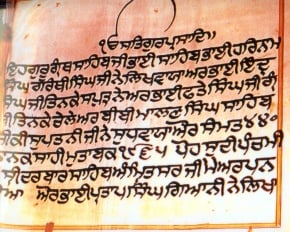
- Main article: Structure of SGGS
Within it's 1430 pages, the shabads (hymns) of the Sri Guru Granth Sahib are arranged in thirty-one Ragas, the traditional Indian musical measures and scales. Within the Ragas, they are arranged by order of the Sikh Gurus, with the shabads of the Hindu and Muslim Saints following. The shabads are written in various meters and rhythms, and are organized accordingly. For instance, Ashtapadi - eight steps, or Panch-padi - five steps. The Sri Guru Granth Sahib is written in Gurmukhi script, but the shabads were written in many different languages including Punjabi, Sanskrit and Persian.
- Main article: Index of Guru Granth Sahib
The original bir of Guru Granth Sahib did not contain an index. However, this is provided in some modern print of the bir to make it easy to find the location of some of the common banis. For example, from the index, (see main article here) it can be seen that the Japji Sahib starts at page 1 and ends at page 8; Sukhmani Sahib is located from pages 262 to 296; the Bara Maha bani can is found at pages 133 to 136; The bani called Anand Sahib(Bliss) can be found at pages 917 to 922, etc.
The Beginning
The Guru Granth Sahib begins with the word "Ek Onkar" – The All Pervading Being. From this Word to the tenth Word “Gur-parshad” is called the Mool Mantra. After this is the rest of the composition called the Japji composed by Guru Nanak Dev. This comprises 38 Pauris or stanzas, a Prologue and an Epilogue. This is one of the morning prayer of the Sikhs.
The next composition has two parts - (1) "So Dar" and (2) "So Purkh". The Bani, "So Dar" contains 5 Shabads and "So Purkh" contains 4 Shabads. This form most of the evening prayer of the Sikhs and is called the Rehras. After this is the Bani called Sohila (full name, Kirtan Sohila), which contains 5 Shabads and is the bed-time prayer.
The 31 Ragas or chapters
- Main article: Ragas in the Guru Granth Sahib
The Adi Granth starts with the a non-raga section which begins with Japji as the first entry followed by Rehras and ending with Kirtan Sohila. Then begins the main section consisting of 31 Ragas or chapters. Although there are 31 Chapters called Ragas in the Guru Granth Sahib, 60 individual musical raga are actually mentioned in the holy book. A raga is a musical structure or set of rules of how to build a melody. It specifies a scale, as well as rules for movements up and down the scale; which notes should figure more and which notes should be used more sparingly; etc. The result is a framework that can be used to compose or improvise melodies in so that melodies in a certain raga will always be recognisable yet allowing endless variation.
Just as a raga has emotional overtone, so each chapter has spiritual implication. The thirty-one ragas appear in the following serial order: Sri raga, Manjh, Gauri, Asa, Gujri, Devagandhari, Bihagara, Wadahans, Sorath, Dhanasri, Jaitsri, Todi, Bairari, Tilang, Suhi, Bilaval, Gond (Gaund), Ramkali, Nut-Narayan, Mali-Gaura, Maru, Tukhar, Kedara, Bhairav (Bhairo), Basant, Sarang, Malar, Kanra, Kalyan, Prabhati and Jaijawanti.
Within the 1430 pages are found Saloks of Bhagat Kabir, Sheikh Farid, Guru Tegh Bahadur, etc.
The closing section
The Main section which consists of 31 chapters forming the the Raga section is followed by a brief closing section. This is composed of the Mundavani (The Closing Seal), a salok by Guru Arjan and the final composition of the SGGS, which is the Ragamala
Historical Volumes of the Siri Guru Granth Sahib
- KARTARPUR VAALI BIR: As described above, Guru Arjun dictated the Adi Granth to Bhai Gur Das. This first volume, or Bir, was made in Amritsar and later transferred to Kartarpur, where it remains today. The opening lines are in the hand of Guru Arjun, and it bears the signature of Guru Hargobind at the end. There are several blank pages, left by Guru Arjun to hold the writings of Guru Teg Bahadur.Apart frommany handwritten copies of Sri Guru Granth Sahib possessed by various persons and found in some gurdwaras the most important is the Bir recension at Kartarpur ,near Jullundur in the custody of Sodhi Amarjit Singh , a descendant of Dhirmal
- BHAI BANNO VAALI BIR: After completing the Adi Granth, Guru Arjun asked one of his Sikhs, Bhai Banno, to take the manuscript to Lahore to have it bound. During this journey, Bhai Banno had a copy made for his own use. He inserted a few Shabads of his own choosing, however. This version remains with his descendents.Hand written Manuscript of Bhai Banno wali Bir is said to be available at Gurdwara Banno Sahib in Kanpur city in India.
- DAMDAMA VAALI BIR: This is the volume dictated by Guru Gobind Singh at Damdama Sahib to Mani Singh. In it, Guru Gobind Singh included the Shabads of Guru Teg Bahadur. The volumes of the Siri Guru Granth Sahib which preside over our Gurdwaras now are copies of this edition.
Using the Gurmukhi Bir and the English Translation
In the West, it has become common to use the English translation of the Siri Guru Granth Sahib in Gurdwara programs and Akhand Paaths, because many of the Western Sikhs are not fluent in Gurmukhi. This has served to bring many to the Feet of the Guru who otherwise may not have had the opportunity to experience the Shabad Guru. It should be noted, however, that it is ideal to install the full Gurmukhi Bir in the Gurdwara in order to fully experience and develop a relationship with the Guru. The English translation can be installed on a separate Palki on the side and serve to illuminate the sangat in the meaning of the Words of the Guru. The English translation may be used during an Akhand Paath in which the participants are not fluent in Gurmukhi. Howev er, if a special Gurdwara program is being planned, the English Akhand Paath days can be accomodated so that the full Gurmukhi Bir of Siri Guru Granth Sahib presides.
A Sikh is encouraged (but not a must) to learn to read Gurmukhi so as to deepen his or her experience of Gurbani and so that the full body of the Guru may be installed in the Gurdwara.
Note: English and other translations of the Sre Guru Granth Sahib Ji should be considered as just another "style" (language) of talking/deitating/praising the guru. Trying to force a person to learn punjabi/gurmukhi is highly undesirable.
Worldwide praise for the holy Granth
- Main article: Worldwide praise for the Guru Granth Sahib
This is what Max Arthur Macauliffe wrote about the authenticity of the Guru's teaching
- The Sikh religion differs as regards the authenticity of its dogmas from most other theological systems. Many of the great teachers the world has known, have not left a line of their own composition and we only know what they taught through tradition or second-hand information. If Pythagoras wrote of his tenets, his writings have not descended to us. We know the teachings of Socrates only through the writings of Plato and Xenophanes. Buddha has left no written memorial of his teaching. Kungfu-tze, known to Europeans as Confuscius, left no documents in which he detailed the principles of his moral and social system. The founder of Christianity did not reduce his doctrines to writing and for them we are obliged to trust to the gospels according to Matthew, Mark, Luke and John. The Arabian Prophet did not himself reduce to writing the chapters of the Quran. They were written or compiled by his adherents and followers. But the compositions of the Sikh Gurus are preserved and we know at first hand what they taught.
| Sikh Scriptures |
- .... "Guru Granth Sahib enshrines the message of universal brotherhood and good of all mankind." said Dalai Lama,The Spiritual Leader Of Tibetian Buddhism .
- ... "I am very much impressed about Sikhism and the bravery of it's followers.I have felt and rightly too that in the welfare of this religion lies the welfare of India." said Col.Phin Mubukant - Minister Of Religious Affairs in Thailand in 1963.
Miss Pearl S. Buck, a Nobel laureate, gives the following comment on receiving the First English translation of the Guru Granth Sahib (The Sikh Holy Book):
- .... I have studied the scriptures of the great religions, but I do not find elsewhere the same power of appeal to the heart and mind as I find here in these volumes. They are compact in spite of their length, and are a revelation of the vast reach of the human heart, varying from the most noble concept of God, to the recognition and indeed the insistence upon the practical needs of the human body. There is something strangely modern about these scriptures and this puzzles me until I learned that they are in fact comparatively modern, compiled as late as the 16th century, when explorers were beginning to discover that the globe upon which we all live is a single entity divided only by arbitrary lines of our own making. Perhaps this sense of unity is the source of power I find in these volumes. They speak to a person of any religion or of none*. They speak for the human heart and the searching mind. ...
(From the foreword to the English translation of the Guru Granth Sahib by Gopal Singh M.A. Ph.D. 1960)(bold added later)
- Dr Gopal Singh M.A Ph.D. (1960). Sri Guru Granth Sahib (English Version). World Book Centre. ISBN.
Guru Granth Sahib Gallery
Message of Guru Granth Sahib
The Guru Granth Sahib provides unique and unequalled guidance and advice to the whole of the human race. It is the torch that will lead humanity out of Kaljug, (the dark era) to a life in peace, tranquillity and spiritual enlightenment for all the nations of the World. The main message can be summaried as:
- 1 All Peoples of the World are Equal
- 2 Women as Equals
- 3 One God for All
- 4 Speak and Live Truthfully
- 5 Control the Five Vices
- 6 Live in God's Hukam
- 7 Practise Humility, Kindness, Compassion, Love, etc
Care & Protocol to be Observed
- Main article: SGGS Protocol
Personal Behaviour
Any person carrying out any Service or Sewa for SGGS MUST observe the following:
- Head must be covered at all times.
- Shoes must be removed outside the Guru's room.
- observe basic standards of personal hygiene.
- If you have to visit the toilet, have a shower and change your clothing before serving the Guru again.
- When reading from the Guru, you must cover your mouth...
- No eating or drinking while in service.
- No small talk while in Guru's service.
While in the vicinity of SGGS, everyone should observe the following:
- Head must be covered at all times.
- Shoes must be removed, especially if indoors.
- When Guru Granth Sahib passes past one must show reverence and respect for the Guru.
Environment
- Guru Granth Sahib should always be placed in an independent, well-ventilated and separate room.
- The floor, walls and ceilings should be cleaned or washed as appropriate and suitably decorated.
- Maharaj has to be placed on a Manji Sahib. The dimension of the Manji Sahib must be at least 12 inches high, 36 inches wide and 18 inches deep.
- A canopy, of suitably material should always be placed over the Guru just below the ceiling.
- Guru's Attire: Clothing appropriate to the season is to be placed upon the throne of the Guru. In the summer, thin clothing and in winter, warm clothing i.e. a thick blanket/duvet must be used.
- The Plain white sheet that is placed under the Manji Sahib is to be of better quality, and separate, to that of the Granthi Singh.
- A Chaur Sahib should be provided besides the Guru with a small platform to house the Kar Parshad and other implements.
On The Move
Whilst the Guru is on the move the following should be observed:
- Five Singhs (Minimum of three) are to accompany the Guru at all times when travelling
- These Singhs are to remain bare-footed.
- One Singh is to do Chaur Sahib Seva
- One Singh is to go ahead of Satguru and sprinkle water or wet flower petals.
- The Main Singh carrying the Guru must put a clean Rumalla on his Turban before carefully and with respect placing the Guru on this Rumalla. At all times, the Guru should be covered with a small Rumalla so that the Guru's Sarop is always fully "covered".
- The other two Singh walk besides the Main Singh – one on his left and the other on his right.
- In order to make the Sangat aware that the Guru is coming in their direction, gongs or other appropriate instruments are to be played or recitation of "Waheguru" at all times.
- When travelling by car, etc, if possible carry the Guru on the head or the lap. In each case a clean Rumalla must be place below the Guru.
Other Considerations
- Maharaj is never to be placed in a closet or cupboard.
- No one should sit on a higher platform than the Guru.
- At night, the Guru should be placed on a separate independent bed or small cot.
See Also
- Gurbani Online
- Worldwide Praise for the Guru Granth Sahib
- Message of Guru Granth Sahib
- Index of Guru Granth Sahib
- Structure of SGGS
- SGGS Protocol
- SGGS translations
- Boundless Scripture of Guru Granth Sahib
- SGGS on charity
- SGGS on Arguing
- SGGS on meat
- Guru Granth Sahib Gallery
- What is the Siri Guru Granth Sahib? -Bibiji
- Guru Granth Sahib Begins Uniquely
- Trumpp's Translation Of Portions Of The Guru Granth Sahib
- Guru Granth Sahib ji - for children
- Sri Guru Granth Sahib ji (Hindi transliteration) - Bhai Mohan Singh Vaid
- Sri Guru Granth Sahib Bantar tey Visha - Dr. Gurmail Singh Tract No. 543
- Sri Guru Granth Sahib Ji Maharaj - Ik Aduti Dharam Granth - Dr. Gurcharan Singh Mehta
- Sri Guru Vyakaran Panchayan - Kartar Singh Dakha
- Sri Guru Granth Sahib vichley Pashu-Panchi Sanketan da Kosh - Dr. Jasbir Singh Sarna
- Guru Granth tey Panth - Gyani Sher Singh
* Sri Guru Granth Sahib Vigyanik Visha Kosh - Dr. Jasbir Singh Sarna
External Links
Gurbani online
- Main article: Gurbani online
- Sri Guru Granth Sahib on www.sikhismguide.org
- Humble Tribute to Sri Guru Granth Sahib
- Video on 400th Anniversary of Sri Guru Granth Sahib
- ECards on Sri Guru Granth Sahib
- guru granth sahib view and search
- Essays on Authenticity of Kartapuri Bir by Daljeet Singh IAS(retd.)
Gurbani search
- Main article: Search Gurbani
- GurbaniDB - Guru Granth Sahib Search Guru Granth Sahib in English, Gurmukhi and 52 other languages, including 52 translations and 22 transliterations
- Srigranth.org Easy and powerful search; unicode text
- Sikhitothemax.com unique - use 4 first letters of shabad; powerful tool; now set as standard for kirtan darbars
- Sikhnet.com Simple; page by page; Raag index
- Srigurugranth.org similar to Sikhnet
- Sikhs.org - SGGS in English Translation Only
- Gurugranthdarpan.com Punjabi version only
- Gurmatps.org Simple Index; English translation Only
- simple.ishwar.com Translation in English Only
Dasam Granth
The following are sites where you can download files comprising the SGGS:
Download SGGS
- www.gurbanifiles.org/
- www.gurbani.org
- www.gurdwaramidhudson.org Download pdf file gurdwaramidhudson.org
- Download the Siri Guru Granth Sahib in Spanish/Español (doc)
Audio files
- ikirtan.com Download mp3 files
- ProudtobeSikh - Listen only - no download
